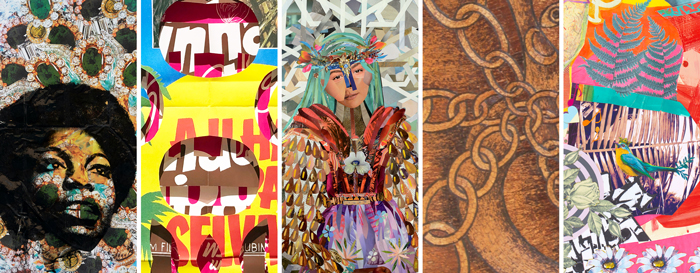
Kolaj is a quarterly, printed, 10″x8″ art magazine
featuring reviews and surveys of contemporary collage. The magazine takes an international perspective on collage as a medium, a genre, a community, and a 21st century art movement..
SUBSCRIBE OR ORDER A COPY
INSIDE THE ISSUE
Barbara Bertino‘s Sailing the Dry Land graces the front cover of Kolaj 36. Odeta Xheka discusses Bertino’s work in a larger article about the painterly influences and attitudes of collage artists. Xheka writes, “These contemporary collage artists continue to explore the versatility of the medium. They are not necessarily looking to convey a message or make a grand statement, but are always on the lookout for innovative ways to satisfy their curiosity in aesthetics and materiality.” Melissa Sutherland Moss‘ Nina Simone, First Lady appears on the back cover and a portfolio of her work appears in the issue.
In Copyright News: As Andy Warhol Foundation v. Lynn Goldsmith Heads to the Supreme Court, Ric Kasini Kadour reports on the case and asks, Is fair use on the line?
Collage in Motion Fellow Laurie O’Brien shares the story of how she found her medium. Christopher Kurts interviews Retama, the first collective of women composers of contemporary music in Peru, about their project to make collage seen & heard.
How many bits are needed to make a collage? We explore the idea of a “Two-Bit Collage,” a playful sort of minimalism illustrated by Gregory Hom’s collage. “Two-bit often means ‘cheap’, and should by extension mean that the work is shoddy or not well-thought-through. But the world of collage as I’ve seen it during the past seven or so years is full of two-bit collages, and they stand up as good work.”
In our round-up of news and notes from the world of collage, we report on Laura Klopfenstein’s collage on the cover of Texas Observer; Portland collagist Kevin Sampsell‘s new book, I Made an Accident; a new journal of poetry and collage by Kolaj Institute; and a series of Collage Artist Residencies taking place in Scotland.
In “A Posthumous Return,” Kelli Bodle writes about how the legacy of Italian Proto-Arte Povera Artist Salvatore Meo may have been eclipsed by Robert Rauschenberg and Cy Twombly.
MJ Connors Davison walks us through how an Exquisite Corpse exhibition became an exquisite community. What began as a World Collage Day project in 2021 became an exhibition at The New Zone Gallery in Eugene, Oregon, USA in 2022.
Jane Laster-Gordon reflects on how her collage series “Gotham City” became an accidental reflection on 9/11 Terrorist Attacks in New York City. “On September 11, 2001, I took an early flight from Toronto to New York. At the exact time the first of the World Trade Center towers was struck, I was in the air and my plane was preparing to land at LaGuardia Airport,” she writes.

Artist Portfolios
Caroline Valansi
Rio de Janeiro, Brazil
Valansi collages this material to “disarticulate and rearticulate” taboos about sexuality and the issues that surround them.
Melissa Sutherland Moss
Brooklyn, New York & Baltimore, Maryland, USA
By placing emphasis on black beauty, I carefully reimagine history through vibrant collage and typography.
Evelyn Rapin
Kingston, Ontario, Canada
Although my art is always driven by a particular idea, I still rely on chance and accident during the process and this approach leads to an expressive and interesting outcome.
Saree Robinson
Grass Valley, California, USA
I use a full magazine subscription—something is pulled off every single page of all 12 issues—to contribute to making one collage.
David Basasira
Kampala, Uganda
A single artwork contains hundreds of cut pieces and for every tiny piece of the fiber you see on the artwork, the artist laid a hand on it. Like all other collage techniques, banana fiber collage, too, is time consuming.
